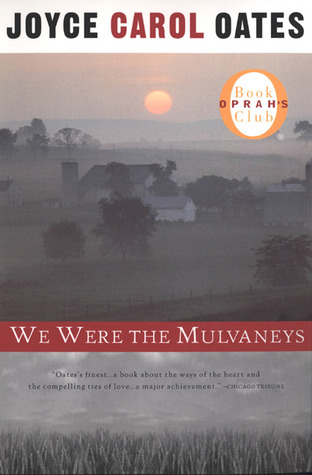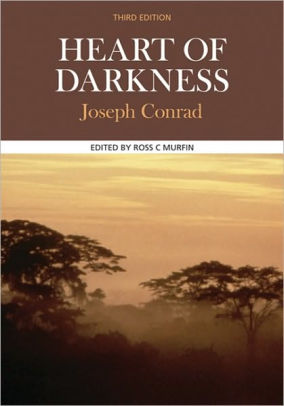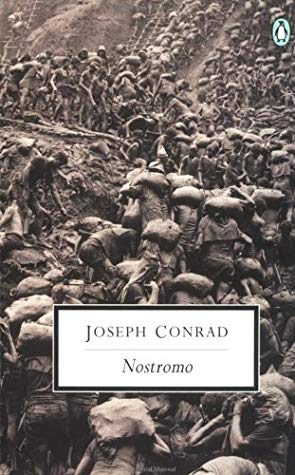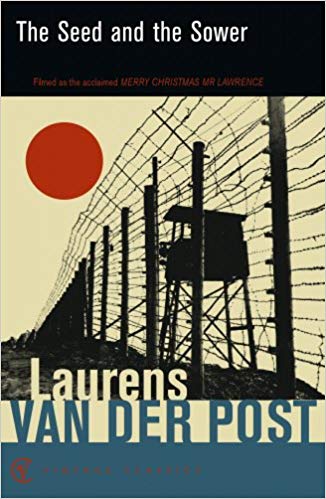Summer reading, nothing freshly published, just books that have sat unread on my shelves, books I’ve been meaning to read but have brushed aside in favour of more immediate demands. These are the books, all novels:
We Were the Mulvaneys, by Joyce Carol Oates
Heart of Darkness, by Joseph Conrad
Nostromo, by Joseph Conrad
The Seed and the Sower, by Laurens van der Post
We Were the Mulvaneys ( * 1/2) — 3 1/2 out of 5

This is one of Oates’ mature novels, published in 1996. It has immediate appeal for me because it is set in upstate New York. When I was very young, our family lived in Syracuse where my father was doing a graduate degree, and so there is something about that region, around the finger lakes, something about the smell of the soil, the trees in autumn, something about it which grounds me. The novel is set on High Point Farm, and the sense of place returns me to my earliest memories of that region. It is told from the point of view of the youngest son, Judd, ostensibly a first person narrative, but this is merely a device to get us into the novel, where Judd sits on the periphery. The Mulvaneys are a prosperous family who have raised themselves up by the boot straps and aspire to move among the best circles in the well-appointed towns of upstate New York. The father, Michael Sr., has established a thriving roofing business, has worked to develop all the right contacts, has even become a member of the best club. The oldest son, “Mule,” is the athlete every father dreams of having, captain of the football team, good-looking, popular with the girls, with a promising future as a college athlete. The second son is equally successful as an academic. Although awkward by the standards of his older brother, nevertheless, he is destined to be the best within his own sphere.
It is their third child, their only daughter, who provides the pivot around which the novel turns. She promises to be just as successful as her brothers: pretty, popular, the only junior to be elected to the homecoming entourage. But after the homecoming, at her second party, after some drinks she isn’t sure she wants, after a ride in a car with a boy she isn’t sure she wants to be with, “it” happens. The Mulvaneys refuse to name what happens, and so the event becomes known as “it.” After “it” happens, Oates follows each of the strands as the Mulvaneys come unraveled. The father has a violent, though disorganized, confrontation with the boy and his father. After the confrontation, in subtle ways, he finds himself ostracized, unable to secure lucrative contracts, and addressed coldly in social situations. He retains one lawyer, then, without satisfaction, moves on to another. He drinks to excess. To support his litigation and his excesses, he sells the assets of High Point Farm piece by piece. Things spiral out of control. And his behaviour impacts upon, and is mirrored by, the behaviour of his children, until it seems the family will disintegrate completely.
The commentary on the dust jacket makes two observations: 1) Oates offers up an indictment of middle class America; & 2) she offers up a wonderful account of redemption. To this, I say: yes, and sort of. Michael Sr. becomes an embodiment of American entrepreneurship when it has lost its moral compass. He scrabbles after things which mean nothing and which provide the family with no real sustenance. The failure of his business points to the more important failure of spiritual support when his children, most especially his daughter, are most needful. The novel does end with a sense of reintegration. The Mulvaneys have undergone a painful transformation, and they have not recovered a sense of themselves as they were, but they have managed to establish something new, a renewed sense of themselves, which is worth having. And yet … I cannot accept the word “redemption” which appears on the dust jacket. Michael Mulvaney Sr. is destroyed, an incorrigible alcoholic, violent at times, driven from his own family, alone, bankrupt. Inevitably, he dies, and it is only after his death that his family finds ways to live at peace with the world.
If this novel is a parable, an indictment of American middle class, then its message is not one of redemption in the strict sense. Instead, whatever is fine and good in life can only come after the diseased parts of it rot and fall away.
Heart of Darkness (* 1/2) — 4 1/2 out of 5

This is arguably Conrad’s most famous work, in part because it forms the basis for the 1979 film, Apocalypse Now. Heart of Darkness also serves as the genesis for his more fully realized Lord Jim which captures more of the moral ambiguity and which points more clearly (in all its lack of clarity) to the post-modern sensibilities of the succeeding generation of writers. Like We Were the Mulvaneys, this is a first person narrative, though here, the narrative voice is more tightly woven into the account. At all times, we know exactly who is speaking and how he has come to know his subject. The same accountability is absent from Oates.
In Heart of Darkness, the narrator tells about his efforts in service of the “company,” his journey up a river in Africa, his approach to Kurtz, the ivory trader who has thrived in a world where his peers have gone mad or have met untimely deaths. As in all Conrad’s other works, the moral landscape is enshrouded with fog. This is presented in a literal account along the river when the narrator’s boat is suddenly pelted with harmless sticks and the riverboat captain is suddenly impaled by a spear (an astonishing scene if you are familiar with Apocalypse Now).
Although short, this novella is a piece which invites (and warrants) reading and re-reading. It speaks to an anxiety which lives in all of us—a fear that each one of us bears the seed of his own undoing. In addition, the novella provides an interesting commentary upon the fate of Michael Mulvaney Sr. Where Conrad offers up an embodiment of our anxieties through Kurtz, Oates offers nothing. We witness only the undoing of a man at the hands of disembodied anxieties. This, I believe, is what makes Conrad a superior read.
Nostromo — 4 out of 5

My edition of Nostromo includes a critical introduction along with notes by Conrad. The introduction cites the enthusiastic response of some of Conrad’s contemporaries—this is one of the greatest novels ever written. I am not so sure. Where Heart of Darkness anticipates the philosophical morass of postmodern thinkers, Nostromo is thoroughly modern. Perhaps its greatness lies in its absolute mastery of a vocabulary, the vocabulary of the romantic, the vocabulary of the grounded. If you want to read the perfect novel as a medium of the 19th century, then this is the definitive read. But if, like me, your predilections have strayed from the culture which precedes our own, then its voice can be off-putting.
First is the point of view. Nostromo is narrated from the point of view of an omniscient third person. In The Rhetoric of Fiction, Wayne C. Booth makes a distinction between showing and telling in prose narrative. These are not two distinct narrative modes; these are poles in a spectrum of voices available to an author. At one pole, telling, we have a god-like voice capable of telling us not merely everything about the subjects of the novel, but everything about everything. For example, Jane Austen, in her most god-like voice, begins Pride and Prejudice with:
“It is a truth universally acknowledged, that a single man in possession of a good fortune, must be in want of a wife.”
How do we know this? What is its source? Do these questions matter? No. Austen says so and that is enough, at least at that time, with that particular sense and sensibility, if you will pardon the expression. But by the 20th century (even earlier) authors had had enough of what they viewed as a false account of the order of things—that reality could be grounded in a single coherent authorial voice. And so, culminating in F. Scott Fitzgerald’s The Great Gatsby, the narrative voice became increasingly contingent, increasingly positioned … and increasingly unreliable as the source for a reader’s information. Novelists eschewed “telling” us anything, letting us assess for ourselves the reliability of all we encountered on the page. Even writers like Henry James, who gave the appearance of writing with a detached voice, managed, through a subtle displacement, to draw us into the mind of the dominant character, all the while using the 3rd person singular to lull us into the belief that we were reading the words of a firmly fixed authorial voice. This latter technique found its ultimate practitioner in Virginia Woolf (see my discussion of Mrs. Dalloway).
The problem with Nostromo (it is a problem for me, situated as I am, and not simply a problem “in the air”) is that it is a long novel dominated by “telling.” Reading it in an age more receptive to the contingent results that come from reading a novel which “shows” us the story without explanation, I find the “telling” voice difficult to accept.
Nostromo tells the story of a fictional South American country, Costaguana, It is set in a coastal city, the economic though not the political capital of the country (much like Toronto is to Canada). The city, the region, the whole country, is dominated by the San Tomé silver mine which lays buried beneath a mountain. An Englishman, Charles Gould, has inherited an enormous burden, a financial albatross, but with clarity of vision and great business acumen, he develops the “Gould Concession” so that it is not merely profitable, but promises to raise the entire country from its petty politics and its dreadful poverty. Certainly this is his declared motivation when he decides to return from Europe to assume authority over the “Gould Concession.” The title character, Nostromo, is an Italian, a Genoese sailor expatriot who has settled in Costaguana. He is head of the “carragadores,” who are essentially stevedores on the local pier. He is confident, seemingly impervious to the local struggles, incorruptible, a lady’s man, generous even in poverty, loved by the simple folk, admired by his employers, feared by his enemies. We see little of Nostromo for the first 150 pages of the novel. He is legendary, larger than life, looming in the background just as the San Tomé looms over the landscape. As the novel progresses, however, we wonder if Nostromo’s incorruptible nature can bear the weight of so much silver flowing down the mountain. Like Oates, Conrad exposes an impossible view of the world. Even as the mine enriches Costaguana, its spent seams undermine the spirit of the people. As with Oates, there is a redemption of sorts, but like Oates, the redemption comes with a price—they must die who embody the world’s corrupt underbelly.
The Seed and the Sower (*1/2) — 2 1/2 out of 5

Like Heart of Darkness, The Seed and the Sower serves as the basis for a well known film, in this instance, Merry Christmas Mr. Lawrence. As I began to read, I wondered why critics might decide that Nostromo was one of the greatest English language novels ever written while letting The Seed and the Sower slide into obscurity. The answer, I think, lies in the nature of the “telling.” When Conrad “tells” his story, the fact that he tells it (rather than shows it) refers only to the authorial distance he assumes when mediating between the reader and the characters in his story. Nostromo (the man) is remote, like the San Tomé mine, an influence of almost mythic nature. But van der Post does something more; he insists on explaining. Explaining is a fatal species of telling. Van der Post tells us a story, shows us some events which advance the plot, then explains what it all means. In fairness, this collection of three novellas is well-written, it is intelligent, it is sensitive to the nuances of human relationships and cultures. Nevertheless, (and perhaps unwittingly) it attracts to itself a moral heavy-handedness which insults the reader and relegates the author to an every-growing circle of skillful hacks.
Even if an author is wholly conscious of all the symbols and all the subtle literary devices strewn through her work, she must nevertheless remain silent in the matter of how to understand the symbols and devices. That is the reader’s job. An author must always presume that at least some of her readers are at least as perceptive as she is. If not, what would be the point of writing in the first instance? Ironically, this makes the book reviewer the most egregious hack of all, since he undertakes to lay bare all the hidden undercurrents of meaning.
The Seed and the Sower is the account of a man, the narrator, who plays host to Mr. Lawrence on Christmas eve and Christmas day several years following World War II. They share recollections of their experiences in Java and later, in a Japanese prisoner-of-war camp. If you know the film, then you know that the pivotal event is a kiss which passes between Maj. Jacques Celliers and the commandant, Yanoi. The movie suggests a sexual tension which is absent in the novel. Van der Post tells us something different, and he makes sure we understand precisely what he means. In pre-war Japan, the public kiss was an act of intentional shame upon the recipient. A sexual gloss in the movie might work to convey a sense of shame to a western audience in the 1980’s, but in post-war Japan, this was nothing more nor less than an insult, like a slap on the face.
Although van der Post’s writing is thoroughly rooted in an earlier era (much like Nostromo), nevertheless, our own inability to interpret its central act (without his help) provides us with a thoroughly post-modern lesson in the nature of literature: meanings are slippery and contingent; even where an author “tells” us what they mean, that explanation itself quickly becomes irrelevant and all we are left with are words.